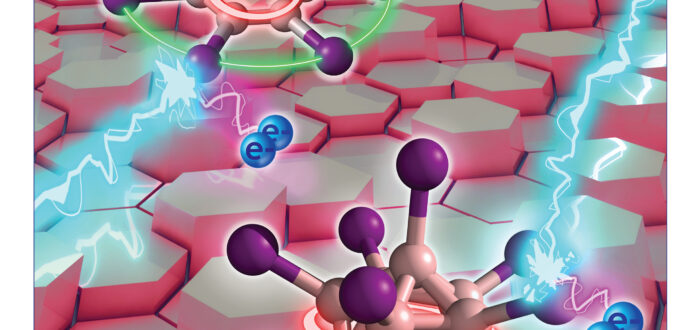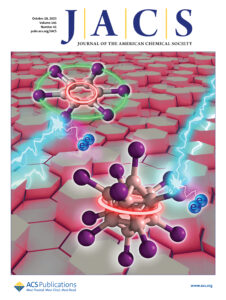Journal of the American Chemical Society features on its supplementary cover the recently published research article “Single-Not Double-3D-Aromaticity in an Oxidized Closo Icosahedral Dodecaiodo-Dodecaborate Cluster”.
3D-aromatic molecules with (distorted) tetrahedral, octahedral, or spherical structures are much less common than typical 2D-aromatic species or even 2D-aromatic-in-3D systems. Closo boranes, [BnHn]2– (5 < n < 14) and carboranes are examples of compounds that are singly 3D-aromatic, and we now explore if there are species that are doubly 3D-aromatic. The most widely known example of a species with double 2D-aromaticity is the hexaiodobenzene dication, [C6I6]2+. This species shows pi-aromaticity in the benzene ring and pi-aromaticity in the outer ring formed by the iodine substituents. Inspired by the hexaiodobenzene dication example, in this work, we explore the potential for double 3D-aromaticity in [B12I12]0/2+. Our results based on magnetic and electronic descriptors of aromaticity together with 11B{1H} NMR experimental spectra of boron-iodinated o-carboranes suggest that these two oxidized forms of a closo icosahedral dodecaiodo-dodecaborate cluster, [B12I12] and [B12I12]2+, behave as doubly 3D-aromatic compounds. However, an evaluation of the energetic contribution of the potential double 3D-aromaticity through homodesmotic reactions shows that delocalization in the I12 shell, in contrast to the 10?-electron I62+ ring in the hexaiodobenzene dication, does not contribute to any stabilization of the system. Therefore, the [B12I12]0/2+ species cannot be considered as doubly 3D-aromatic. Cover art: Sílvia Escayola
The corresponding paper was published recently:
Jordi Poater, Sílvia Escayola, Albert Poater, Francesc Teixidor, Henrik Ottosson, Clara Viñas, Miquel Solà
Single-Not Double-3D-Aromaticity in an OxidizedCloso Icosahedral Dodecaiodo-Dodecaborate Cluster
J. Am. Chem. Soc., 2023, 145, 22527–22538
DOI: 10.1021/jacs.3c07335
Girona, Oct 23, 2023
For more info: ges.iqcc@udg.edu


